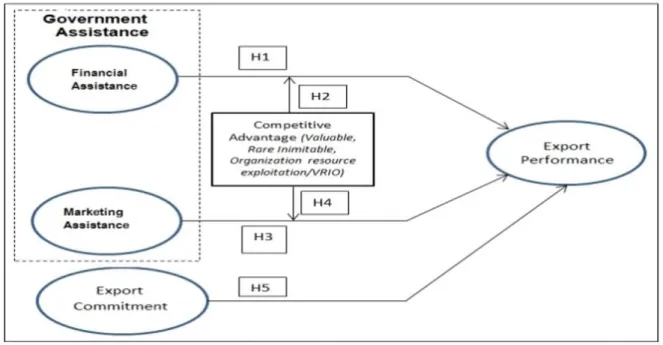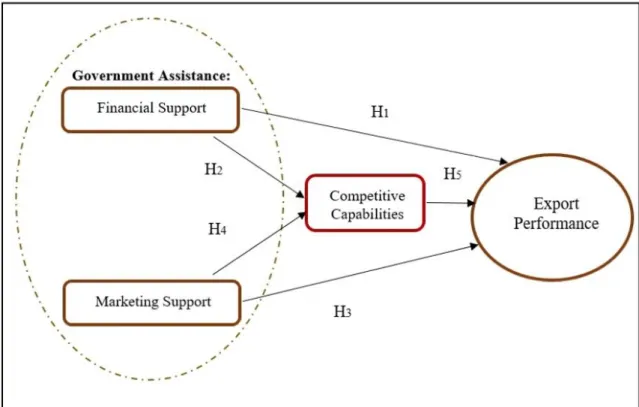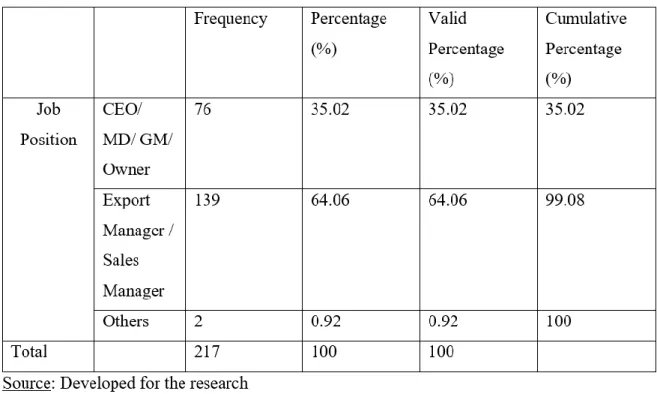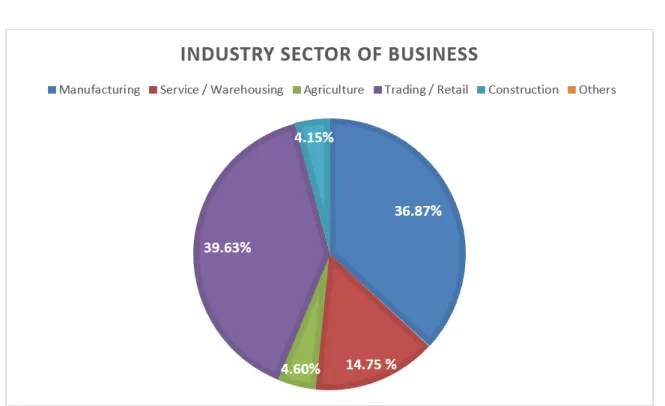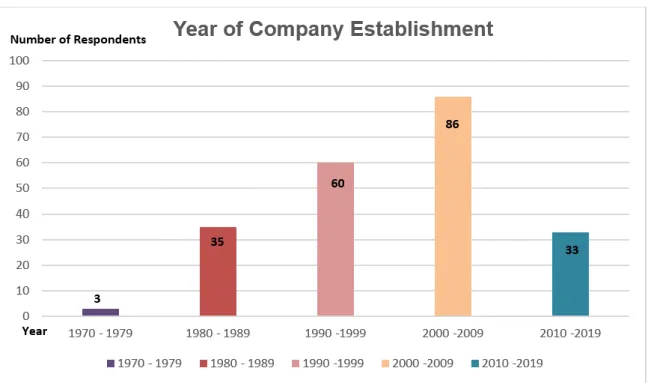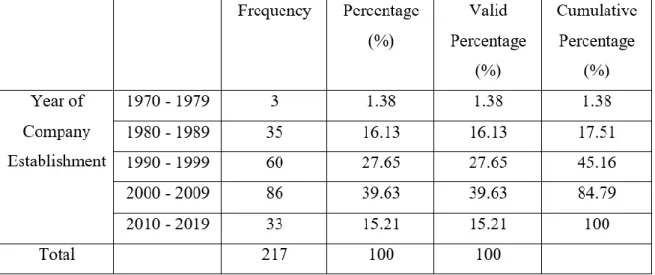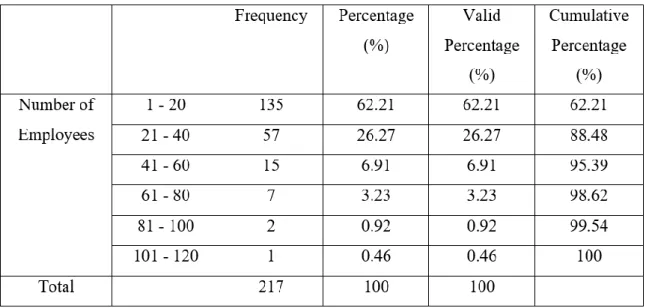Besides that, researchers also want to dedicate this research study to our beloved and respected supervisor, Dr. Mohammad Falahat, who provided us valuable guidance and assistance throughout the completion of this research project. Finally, we dedicate this research study to all our dear friends for their immense help, support, encouragement and valuable feedback to make our research successful. The contributors to internalization for SMEs in Malaysia are identified in this research study as government support in marketing and financial support.
Finally, this research can hopefully provide a better understanding of the key success factors and challenges faced by small and medium-sized enterprises (SMEs) on their way to internationalization.
INTRODUCTION
- Introduction
- Research Background
- Research Problems
- Research Objectives
- General Objectives
- Specific Objectives
- Research Questions
- Hypotheses of the Study
- Research Significance
- Managerial Implications: Small-Medium Enterprises (SMEs)
- Central Coordinating Agency (CCA): SME Corporation Malaysia
- Policy Maker: Government
- Chapter Layout
- Conclusion
Maintaining high competitiveness and expanding business internationally are becoming challenging especially in the global market. Therefore, the primary purpose of this research is to examine and analyze the essential factors that affect the competitiveness and performance of firms in the international market. The main objective of this research is to examine and analyze the essential factors that influence the competitive abilities and performance of firms in the international market. i).
Since the reason for this research is to determine the critical factors that contributed to the competitiveness and performance of Malaysian SMEs in the international market, this research aimed to answer the following questions: -.
LITERATURE REVIEW
Introduction
Secondary data such as data from journals, articles and books have been collected and summarized in this part. In this chapter, it will start by reviewing and defining each possible independent variable that can influence the success of SMEs moving towards internationalization, based on relevant previous studies and literature. The definition and explanation of dependent and independent variables will also be included in this chapter.
In addition, a proposed conceptual framework will be presented as well as hypotheses that will be used to examine the relationship between independent variables and dependent variable.
Review of the Literature
- Theoretical Foundations of Firm Export Performance
- Definitions, Determinants and Measures of Export Performance
- Independent Variable
- Government Assistance: Financial Support
- Government Assistance: Marketing Support
- Mediator Variable
- Competitive Capabilities
The third dimension is adaptability, which indicates the firm's ability to respond to changing conditions and opportunities in the environment (Walker & Ruekert, 1987). Determinants of export performance can be classified into two groups, namely internal and external factors of the company (Reid, 1981). The context of the external environment generally affects the performance of the firm by increasing the availability of resources or withholding them.
According to Barney (2012) based on RBT, permanent competitive advantage is only achieved when resources are valuable, rare, inimitable, and the firm's organization enables exploitation (VRIO) of the resources' potential.
Review of Relevant Theoretical Models
Next, this research also examines the moderation of the relationship between financial assistance and marketing support and early internationalization firm performance in a developing country's low-tech industrial environment (Indrawati et al., 2018). Competitive advantage is used as a moderator, acting as one of the most important internal determinants of export performance and highly relevant in early internationalization firms.
Proposed Research Framework
The relationship between the independent variables and the dependent variables will be determined in this research to identify if there is a significant relationship between the variables.
Hypotheses Development
- Relationship between Government Assistance: Financial Support and
- Relationship between Government Assistance: Financial Support and
- Relationship between Government Assistance: Marketing Support and
- Relationship between Government Assistance: Marketing Support and
- Relationship between Competitive Capabilities and Export Performance 29
According to Lengler (2013), the main conclusion of the previous research is that financial support does not appear in the existing literature dealing with the export performance of SMEs. However, Ling-Yee and Ogunmokun's (2001) paper on competitive advantage and export performance supports that financial remittances positively affect competitive advantage and thus superior export performance. In addition, Sousa et al. 2008) highlighted the positive effect of programs sponsored by governments and non-governmental agencies on export performance.
There is a significant positive relationship between financial support and the competitiveness of SMEs in internationalization. H3: There is a significant positive relationship between marketing support and export performance of SMEs in internationalization. According to Fang & Zou (2009), marketing execution capabilities are directly related to a company's success in adapting to the unfamiliar environment of a foreign market. 2016) suggested that superior export performance can be fostered by improving a firm's marketing performance capabilities.
Thus, based on Chen et al. 2016), the authors suggested that the relationship between market information capabilities and export performance is mediated by the implementation of competitive capabilities. In conclusion, various empirical studies have explicitly confirmed that there is a positive direct relationship between export marketing assistance as a competitive advantage and the export performance of early internationalizing firms (Indrawati et al., 2018). Furthermore, the relationship between export market assistance as a competitive advantage and export performance is positively moderated by competitive advantage.
Based on Indrawati et al. 2018), the authors explicitly included the moderation of competitive advantage on the relationship between export marketing assistance and export performance. Gencturk (2001) was the first to provide a positive explanation for the relationship between the use of export assistance and export performance.
METHODOLOGY
Introduction
Research Design
Data Collection Methods
- Primary Data
Sampling Design
- Target Population
- Sampling Frame and Sampling Location
- Sampling Elements
- Sampling Technique
- Sampling Size
Research Instrument
- Questionnaire Survey
- Design of the Questionnaire
Construct Measurement
- Origin of Construct
- Scale of Measurement
- Nominal Scale
- Ordinal Scale
- Interval Scale
Data Processing
- Questionnaire Checking
- Data Editing
- Data Coding
- Data Transcribing
- Data Cleaning
Data Analysis
- Descriptive Analysis
- Measurement Model
- Individual Item Reliability
- Internal Consistency Reliability
- Convergent Validity
- Discriminant Validity
- Structural Model
Conclusion
DATA ANALYSIS
Introduction
In this chapter, data collected from the respondents will be analyzed using Statistical Package Society Science (SPSS) version 25.0 and SmartPLS version 3.2.1. This chapter involved descriptive analysis, inferential analysis, individual item reliability, internal consistency reliability, convergent validity, discriminant validity and structural model to verify the relationship between the variables. Finally, there will be a conclusion for this chapter by summarizing about the hypothesis findings.
Descriptive Analysis
- Respondent’s Demographic Profile
- Job Position
- Industry Sector of Business
- Year of Company Establishment
- Number of Employees
- Year of First Exporting
- First Exporting Country of Company Entered
- Factors that Allows Company to Enter First Exporting Country
- Total Annual Sales Turnover
- Choice of Mode of Entry into First Exporting Market
Research shows that most of the respondents hold a position as "Export Manager" and "Sales Manager", which consists of 64.06% of the total number of respondents with a workforce of 139 people. The fewest number of respondents came from another position, which is only 0.92% of the total number of respondents with a workforce of 2 people. Most of the respondents' companies exported their business for the first time in the year 2000 to 2009 with 85 respondents (39.17%), while the fewest number of first-time exporters are between the year 1970 and 1979, which consists of only two companies (0.92%).
Both Brunei and Hong Kong's markets consist of the same number of 5 companies (2.31%), followed by Australia and the United States, which consist of 3 companies (1.38%). Convenience is the highest factor occupying up to 22.11% of the 107 respondents, while the least number of factors that allow the company to enter the first exporting country is less competition in the exporting country, which consists of only 43 respondents (8.88%). The remaining network and referral factor consists of 60 respondents (12.40%) followed by the government support factor to 46 respondents (9.50%).
Most of the respondents' total annual turnover is over 300,000 to 3,000,000 RM, which is 67.74% with a number of employees of 147 respondents. Next, 14.75% of respondents total annual sales revenue falls within the range above RM3 million to RM15 million with an employee count of 32 respondents, 13.82% of respondents in the range below RM300k with an employee count of 30 respondents. The remaining 2.77% of the respondents have their total annual sales revenue in the range above RM15 million to RM20 million with a headcount of 6 respondents.
Most of the respondents' choice to access the first export market is exporting, which consists of 43.78% with a workforce of 95 respondents. However, the least percentage of respondents' choice of entry mode in this survey is franchising, which consists of 0.46% with a head count of 1 respondent.
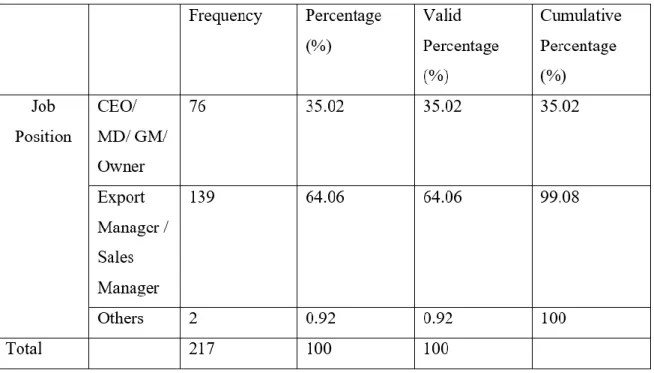
Measurement Scale
- Data Reliability
- Internal Consistency Reliability Analysis
- Convergent Validity
- Discriminant Validity
- Heterotrait-Monotrait Ratio of Correlations (HTMT)
All items have loadings above 0.50, exceeding the recommended threshold of 0.7. Based on Table 4.10, the value of Cronbach's alpha for marketing support, financial support, competitive advantage and export performance is 0.911, respectively. The alpha values for all variables are greater than 0.7, which means they are highly reliable and consistent to measure the reliability of data research.
In Table 4.11, all composite confidence values of the variables are above 0.60, reaching the acceptable level for the study (Bernstein, 1994). The composite confidence values of 0.982 (marketing support), 0.930 (financial support), 0.974 (competitiveness) and 0.931 (export performance) stated that the evaluation of indicator variables is reliable and internally consistent. The AVE value for each construct shown in Table 4.12 exceeded the inch of rule of 0.50.
When the AVE has a value above 0.5, it shows that the latent variable in the model can explain more than the indicator's variance. When the AVE value is below 0.50, it shows that there will be errors in the items described by the variance (Hair, et al., 2013). According to table 4.13, all the value of Heterotrait-Monotrait Ratio of Correlations for marketing support, financial support and export performance with competitive advantage are and 0.947 respectively.
In addition, the value for export and marketing support for financial support are 0.736 and 0.925 respectively. The HTMT value for all variables is greater than 0.7, which means that these variables in the model provide a sufficient level of reliable and valid data for the survey.
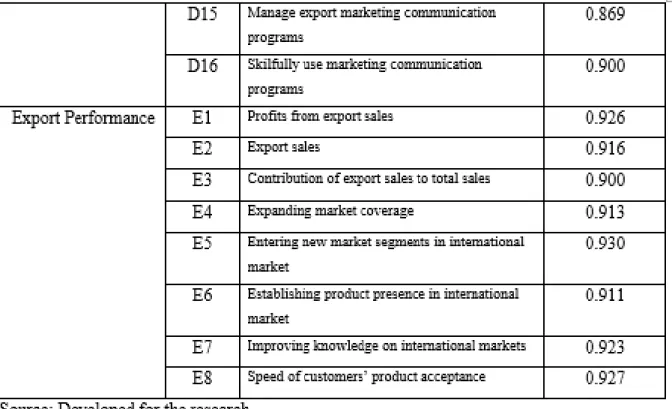
Structural Model
Hypotheses Testing
Thus, H3 is accepted, indicating that there is a positive significant relationship between marketing support and export performance. Thus, H4 is accepted, indicating that there is a positive significant relationship between marketing support and competitive capabilities. Thus, H5 is accepted, indicating that there is a positive significant relationship between competitive capabilities and export performance.
Conclusion
DISCUSSION, CONCLUSION AND IMPLICATIONS
- Introduction
- Discussions of Major Findings
- Implications of the Study
- Managerial Implications: Small-Medium Enterprises (SMEs)
- Policy Maker
- Limitations of the Study
- Insufficient independent Variables
- Limited Geographical Coverage of Target Respondents
- Time and Financial Constraints
- Recommendations for Future Research
- Improve Distribution Method for the Questionnaire
- Using Bilingual Languages in the Questionnaire
- Broaden the Research Setting
- Conclusion
According to Lengler (2013), the study suggested that the export financing constraints faced due to the complex trade instruments, lack of organizational resources and the operations of exporters will only partially affect the performance of the SMEs. Based on Chen et al. 2016) research, the authors suggested that marketing information capabilities have a relationship with export performance that is mediated by the implementation of competitive capabilities. The outcome of this study provides knowledge and information regarding the critical factors and challenges that will affect the SMEs after internationalization through export performance.
The state support of the companies acted as a significant role in the improvement of the economic performance of the SMEs. Time and financial constraints in this study limited the conduct of the survey to a greater geographical coverage of the target respondents. Marketing support and competitiveness found to be crucial for SMEs' export performance in the international market.
While the findings indicate that financial support is not decisive in obtaining competitive capabilities and export performance. The Effect of State-Designed Export Promotion Service Use on Small and Medium-Sized Enterprise Goal Attainment: A Multidimensional View of Export Performance. The antecedents of export performance of Brazilian SMEs: the nonlinear effects of customer orientation.
The impact of financial resources on export performance - the case of Portuguese exporting companies. The influence of relational capability and marketing capability on export performance of firms in emerging markets.
SME’s Definition in Malaysia
Percentage Share of SMEs GDP and Malaysia ‘s GDP for 2017
Summary of SMEs Involvement in Malaysia
Questionnaire
Discriminant Validity of Construct
Loadings for Each Variable
Loadings and Cross Loadings
